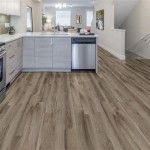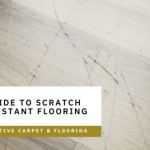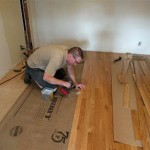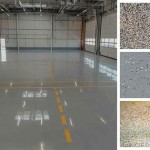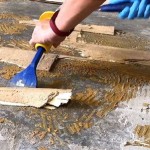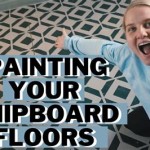Can You Put Vinyl Flooring on Walls?
Vinyl flooring has long been a popular choice for its durability, water resistance, and affordability. While traditionally used for floors, its versatility has led many to explore its potential as a wall covering. This article will explore the feasibility, benefits, drawbacks, and installation process of using vinyl flooring on walls.
Feasibility and Suitability
Technically, vinyl flooring can be installed on walls. However, several factors determine its suitability for a specific project. The type of vinyl flooring plays a significant role. Click-lock or loose-lay vinyl planks designed for flooring are generally not recommended for vertical applications. Their weight and the reliance on gravity for stability make them unsuitable for wall installations. Adhesive-backed vinyl flooring and vinyl sheets or tiles, on the other hand, are better suited for walls. Their adhesive backing or compatibility with wall adhesives provides the necessary secure attachment.
The wall's condition also influences the success of the installation. Walls must be clean, dry, and smooth. Imperfections like bumps or cracks can show through the vinyl, compromising the aesthetic appeal. Proper surface preparation is crucial for a smooth and even finish. Additionally, the environment plays a role. Areas with high humidity or temperature fluctuations may not be ideal for vinyl wall coverings, as these conditions can affect the adhesive and the vinyl itself. Careful consideration of these factors is essential before embarking on a vinyl wall installation.
Benefits of Using Vinyl Flooring on Walls
Using vinyl flooring on walls offers several advantages. One of the most significant is its exceptional water resistance. This makes it an ideal choice for areas prone to moisture, such as bathrooms, kitchens, and laundry rooms. Vinyl can withstand splashes and spills without warping or sustaining water damage, offering a hygienic and easy-to-clean surface. Furthermore, vinyl flooring comes in a wide variety of styles, colors, and patterns, mimicking the look of natural materials like wood, stone, or tile. This design versatility allows for creative expression and customization, providing an opportunity to achieve unique aesthetic effects.
Another key benefit is its durability. Vinyl flooring is known for its resistance to scratches, scuffs, and dents, making it a durable wall covering option, especially in high-traffic areas. This robustness contributes to its longevity, reducing the need for frequent replacements and minimizing maintenance efforts. The relative ease of installation compared to some other wall coverings also makes vinyl an attractive option. Adhesive-backed vinyl, in particular, simplifies the process, making it a manageable DIY project for many homeowners.
Drawbacks and Considerations
While vinyl flooring offers several benefits as a wall covering, certain drawbacks warrant consideration. One potential issue is its susceptibility to temperature fluctuations. Extreme heat or cold can cause the vinyl to expand or contract, potentially leading to warping or cracking. Installing vinyl in areas with significant temperature variations is therefore not recommended. Another concern is its limited breathability. Unlike some other wall coverings, vinyl does not allow moisture to pass through easily. This can trap moisture behind the vinyl, potentially leading to mold or mildew growth, particularly in humid environments. Proper ventilation and moisture management are crucial to mitigate this risk.
The adhesive used for installation can also present challenges. Some adhesives may emit volatile organic compounds (VOCs), which can negatively impact indoor air quality. Choosing low-VOC or VOC-free adhesives is essential for maintaining a healthy indoor environment. Furthermore, removing vinyl flooring from walls can be more difficult than removing it from floors. The strong adhesive bond can damage the underlying wall surface during removal, requiring repairs or extensive patching. Carefully weighing these potential downsides alongside the benefits is vital for making informed decisions about using vinyl flooring on walls.
Installation Process
Proper installation is crucial for achieving a successful and long-lasting vinyl wall application. The first step involves thorough surface preparation. The wall must be clean, dry, and free of any dust, debris, or loose paint. Any imperfections, such as cracks or holes, should be filled and sanded smooth. A primer may be necessary to ensure proper adhesion of the vinyl. Once the wall is prepared, the vinyl can be applied. For adhesive-backed vinyl, simply peel off the backing and carefully adhere the vinyl to the wall, smoothing out any air bubbles as you go. For vinyl that requires separate adhesive, apply the adhesive to the wall according to the manufacturer's instructions and then carefully position the vinyl, ensuring proper alignment and a smooth, even finish.
Cutting the vinyl to fit around corners, edges, and fixtures requires precision and the appropriate tools. A sharp utility knife and a straight edge are essential for making clean, accurate cuts. Measuring twice and cutting once is a good practice to avoid costly mistakes. For larger areas, a vinyl cutter may be helpful. Once the vinyl is installed, it's essential to firmly press it against the wall to ensure a strong bond and eliminate any remaining air bubbles. A roller can be used to apply even pressure and achieve a smooth, professional-looking finish.

How To Install Vinyl Plank Flooring On Walls Europine

Tips On Installing Vinyl Flooring Walls Ll

Going Up The Wall Installing Flooring Vertically Floor Trends Installation

Can Vinyl Flooring Be Used On Walls Home Expo Asia

Lvt Versatile For Floor And Wall Covering S

Laminate And Vinyl Cladding Finfloor

Lvt Versatile For Floor And Wall Covering S

Diy Wood Accent Wall Using Vinyl Planks Love Renovations

Wall Cladding With Flooring Material 2024 09 23 Floor Trends Installation

Can You Use Vinyl Flooring On Bathroom Walls Answered W Tips Small Remodel Rustic Lighting
See Also
